As businesses explore how to integrate AI into their daily operations, many discover the potential of custom large language models, or LLMs. These models can be tailored to meet specific business needs and provide highly accurate outputs that align with unique company goals. For teams learning how to build AI solutions that are both powerful and practical, custom LLMs offer a promising path—but building and deploying these tools can be a daunting task fraught with technical challenges. It’s not uncommon for teams to give up or settle for less efficient solutions before they even get started. In this article, we’ll explore how Flowise AI can help your organization build and scale custom LLM workflows more efficiently so you can overcome technical roadblocks and get back to achieving your business objectives.
Lamatic’s Flowise AI solution simplifies the process by providing an intuitive interface for creating LLM applications. This relieves your team of the technical burdens so they can focus on innovation.
What Is Flowise AI and Why Consider Alternatives?
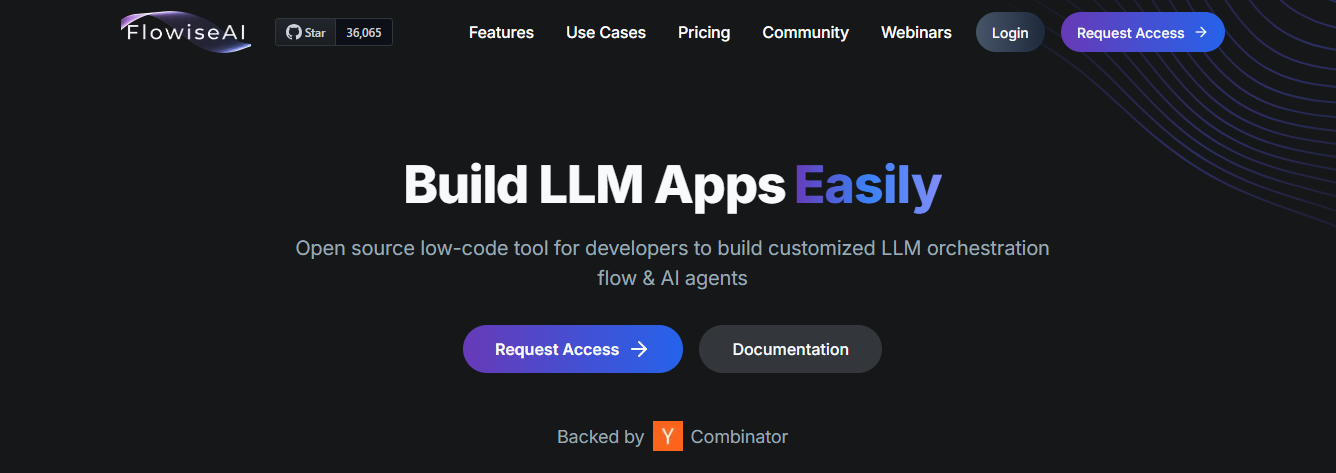
Flowise AI is an open-source platform that enables users to build AI agents, design AI workflows, and create AI-powered solutions with minimal coding. Its drag-and-drop interface and no-code capabilities allow chatbots, virtual assistants, and intelligent automation tools to be easily made. It supports machine learning model execution, will enable you to store unlimited vector data, and integrates with social media channels.
How Does Flowise AI Work?
Flowise AI is an open-source visual tool for building LLM workflows using a node-based architecture. It simplifies the development of custom LLM applications by integrating components like prompt templates, models, memory, and tools. Typical use cases include chatbots, agents, and document Q&A.
Why Look for Flowise AI Alternatives?
Flowise AI is powerful, but it’s not always the best choice.
Here’s why you might want an alternative:
- Steep learning curve: Despite its no-code features, Flowise AI requires technical knowledge to customize AI tools and optimize workflows fully.
- Inflexible AI agent framework: It lacks support for future-proof, code-first agents, and seamless API integration.
- Limited customization: It lacks flexibility when tailoring AI assistants, dynamic input variables, and diverse control flows.
- Hosting constraints: Flowise AI offers limited dedicated hosting solutions to remote providers, restricting cloud deployment options.
- Weak monitoring capabilities: It does not provide a robust tracker or detailed analytics to monitor agent performance.
- Limited AI Interactions: Flowise AI lacks natural language speech recognition, human contact channels, and AI voice assistant capabilities.
Related Reading
- Gen AI vs AI
- GenAI Applications
- Generative AI Customer Experience
- Generative AI Automation
- Generative AI Risks
- How to Create an AI App
- AI Product Development
- GenAI Tools
- Enterprise Generative AI Tools
- Generative AI Development Services
26 Best Flowise AI Alternatives for Custom LLM Applications
1. Lamatic
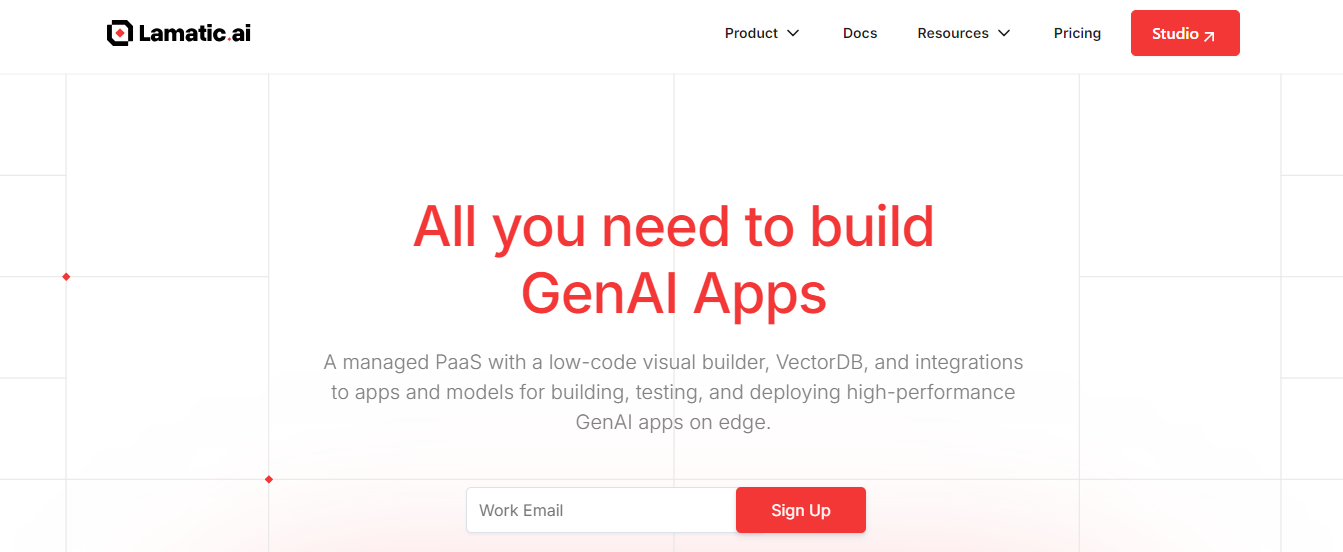
Lamatic is a production-grade alternative to Flowise AI that solves what Flowise can’t:
- Scalability
- Automation
- Edge deployment
While Flowise is great for visual prototyping, Lamatic is built for real-world GenAI applications with features like:
- Low-code agent builder
- Custom GraphQL API, CI/CD automation for GenAI workflows
- GenOps tooling (DevOps for AI)
It goes further with edge deployment via Cloudflare Workers and a built-in Weaviate vector database, enabling real-time performance and scalable memory. Lamatic is ideal for teams who want to move beyond drag-and-drop experiments and ship production-ready GenAI products: fast, reliably, and without accruing tech debt.
Key Advantages Over Flowise AI
- Built-in CI/CD for automated GenAI workflow deployment (Flowise lacks this).
- Edge deployment support is available via Cloudflare Workers (Flowise is server-bound).
- GraphQL API + GenOps tooling, enabling deep integration and DevOps alignment.
- Production-grade stability, while Flowise is better suited for prototyping.
2. LLMStack: Best Scalable AI-Powered Application Builder

LLMStack enables developers to easily build AI agents while ensuring secure and compliant operations. Its robust monitoring capabilities help teams track AI conversations and execute large language models (LLMs) effectively.
Whether managing financial news, developing virtual assistants, or integrating AI for social media, LLMStack ensures future-proof agents with hosted and remote support.
Features
- Create AI-powered software solutions by chaining multiple AI models.
- Customize autonomous AI agents for specific tasks.
- Monitor AI agent performance with monitoring tools.
LLMStack Limitations
- Produces syntactically correct code that may be functionally incorrect, potentially causing bugs.
- Struggles with intricate algorithms or highly specialized domain knowledge.
3. MagicFlow: Best AI Tool For Image Generation

Looking to experiment with Gen-AI images? Try MagicFlow. It’s the perfect tool for optimizing image generation and evaluation, allowing you to easily scale and test models and pipelines.
MagicFlow also helps create social media graphics and generate images in bulk using a user-friendly GUI. It even analyzes thousands of images with advanced visualizations and allows you to collaborate by rating and discussing them with your team.
Features
- Build AI workflows using a user-friendly visual interface.
- Collaborate with team members to evaluate and improve workflows.
- Generate and analyze large volumes of data or images efficiently.
MagicFlow Limitations
- Primarily focuses on image generation workflows, limiting its applicability to other AI tasks.
- Some occasionally experienced bugs or glitches, disrupting workflows and leading to data loss or errors.
4. Dify: Best Generative AI Application Development Tool

Dify is an open-source platform that makes building and running generative AI apps easier. You can set up key parts of your app using simple YAML files, like prompts and context. It also lets you visually organize prompts and manage datasets to build and integrate AI apps quickly. Plus, you can add custom or pre-built tools to boost your AI agents’ capabilities.
Features
- Develop applications with visual orchestration tools for various types.
- Utilize comprehensive analytics to track and optimize agent performance.
- Tailor AI agents to perform complex tasks.
Dify Limitations
- Complex YAML configurations make understanding how different parts of AI applications interact hard.
- The visual interface often overwhelms users with information, making them lose focus.
5. Langchain: Best Development Tool For AI Assistants And Agents
LangChain lets you seamlessly integrate large language models into your applications and build context-aware AI, such as chatbots and virtual assistants, that respond naturally to user inputs. Its framework supports retrieval-augmented generation.
This means you can develop AI-powered customer service agents to facilitate real-time information retrieval and assist users effectively.
Features
- Enhance AI conversations with retrieval-augmented generation.
- Deploy AI workflows on your own cloud infrastructure.
- Scale AI agents efficiently across various platforms.
LangChain Limitations
- Lacks drag-and-drop functionality for non-developers.
- Setting up retrieval-augmented generation can be challenging for some users.
6. IBM Watson Assistant: Best Intelligent Virtual Agents Developer Tool
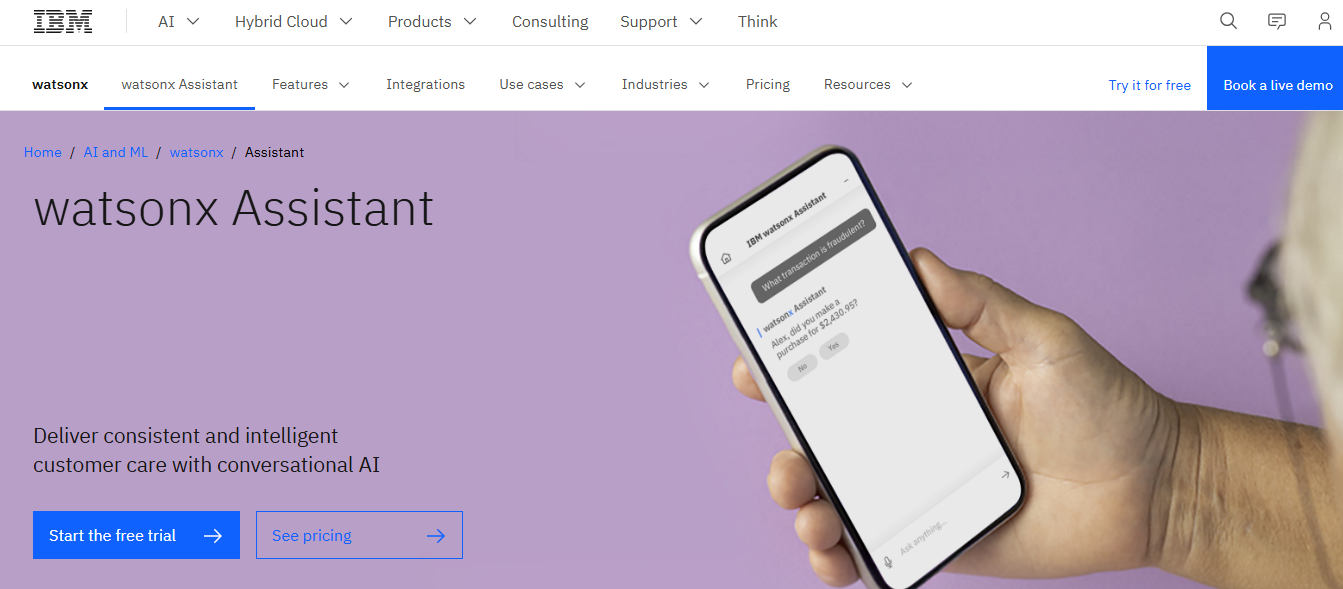
IBM Watson Assistant offers an AI-powered virtual agent that delivers fast, consistent, and accurate responses across various channels. You can utilize it to build intelligent chatbots and voice assistants, providing automated self-service support to your customers. Using its NLP capabilities, you can deploy a chatbot on your website to assist users with common inquiries, reducing wait times and improving satisfaction.
Features
- Adopt natural language processing to understand customer queries accurately
- Integrate seamlessly with existing business tools to enhance operational workflows.
- Deploy across multiple channels, including:
- Web
- Mobile
- Voice platforms
IBM Watson Assistant Limitations
- Its Initial configuration may be challenging for users without technical expertise.
- Some users report that customer support responsiveness could be improved.
7. Rasa: Best Custom Conversational AI Solution Developer
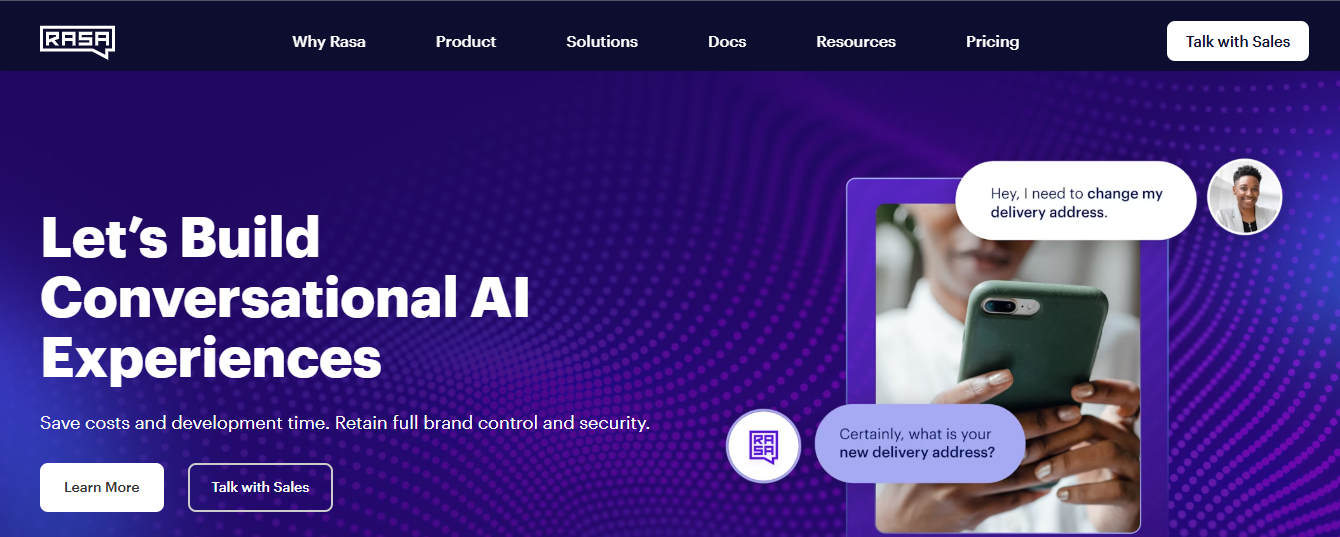
Rasa is an open-source platform for building advanced conversational AI agents tailored to your needs. It empowers developers and business teams to create chat and voice interfaces that effectively understand and process human language. For instance, you can develop a customer service bot that handles inquiries on your website, enhancing user engagement and satisfaction.
Features
- Design conversational flows effortlessly using Rasa Studio’s intuitive no-code interface Integrate seamlessly with existing systems to enhance your assistant’s capabilities.
- Leverage advanced natural language processing to interpret user inputs accurately.
Rasa Limitations
- Deploying Rasa in production can be complex and may require DevOps skills.
- Some users find the documentation lacking detailed examples for advanced use cases.
8. Streamlit: Best Interactive Data Visualization Dashboard Builder

Streamlit is an open-source Python library that enables you to transform data scripts into interactive web applications effortlessly. For a machine learning engineer, Streamlit allows one to create and share custom data apps without requiring web development expertise. For example, you can create a real-time dashboard to monitor my ML model’s performance, helping me interpret results and make informed decisions.
Features
- Create interactive web apps using only Python; no HTML or JavaScript is needed
- Implement real-time updates to visualize data changes instantly during analysis
- Use seamless integration with popular data science libraries like Pandas and Matplotlib
Streamlit Limitations
Operates in a single-threaded manner, which can affect the performance of certain applications Doesn’t support the nesting of views, which can limit the design of an application layout
9. Lyzr: Best Tool For Building Generative AI Applications
Lyzr’s robust agent framework is designed to simplify the creation of generative AI applications. It offers fully integrated agents with pre-built Retrieval-Augmented Generation (RAG) pipelines, enabling you to build and launch applications in minutes. With Lyzr, you can develop chatbots, knowledge search tools, data analysis systems, and multi-agent workflow automation with minimal effort.
Lyzr best features
- Build and launch AI agents swiftly using pre-built RAG pipelines.
- Develop complex AI applications with minimal coding, enhancing accessibility.
- Integrate AI agents into existing systems without extensive reconfiguration.
Lyzr limitations
- Detailed documentation and user reviews are scarce, potentially hindering informed decision-making.
- Mainly targets enterprises, which may limit applicability for smaller businesses or individual developers.
10. Gradio: Best User-Friendly Ai Demo Creator

Gradio is your shortcut to building sleek, user-friendly web interfaces for your machine learning models. No coding marathon required. Whether a developer or data scientist, Gradio lets you showcase your AI-powered agents interactively.
For instance, you can build a web-based demo for an image classification model, enabling users to upload images and receive predictions in real time. This intuitive interface enhances the accessibility and shareability of your AI projects.
Features
- Quickly develop interactive demos for AI models with minimal coding.
- Embed interactive demos into websites or blogs to reach a broader audience.
- Share your models with peers effortlessly for collaborative development.
Gradio Limitations
- Primarily designed for Python, limiting use to other programming languages.
- Not ideal for deploying large-scale AI agents without additional infrastructure.
11. Kubeflow Pipelines

Kubeflow Pipelines is what I turn to when I need raw power and scalability. Built specifically for Kubernetes, it’s designed to handle distributed workflows at an enterprise scale. This tool feels natural if your project involves handling massive datasets or deploying models across multiple nodes.
Features
- Native integration with Kubernetes, making it ideal for large-scale, cloud-native workflows.
- Comprehensive versioning and lineage tracking for pipeline runs.
- A modular approach that lets you plug in custom components seamlessly.
Comparison to Flowise
Flowise is great for simpler pipelines, but when it comes to distributed, production-grade workflows, it doesn’t come close to Kubeflow. That said, Kubeflow’s complexity is not the best option for prototyping or quick iterations.
Limitations
- This might surprise you: Kubeflow’s steep learning curve can be a hurdle, especially if you’re not comfortable with Kubernetes.
- Setting it up takes time, but it’s worth the effort once it's running.
12. Haystack
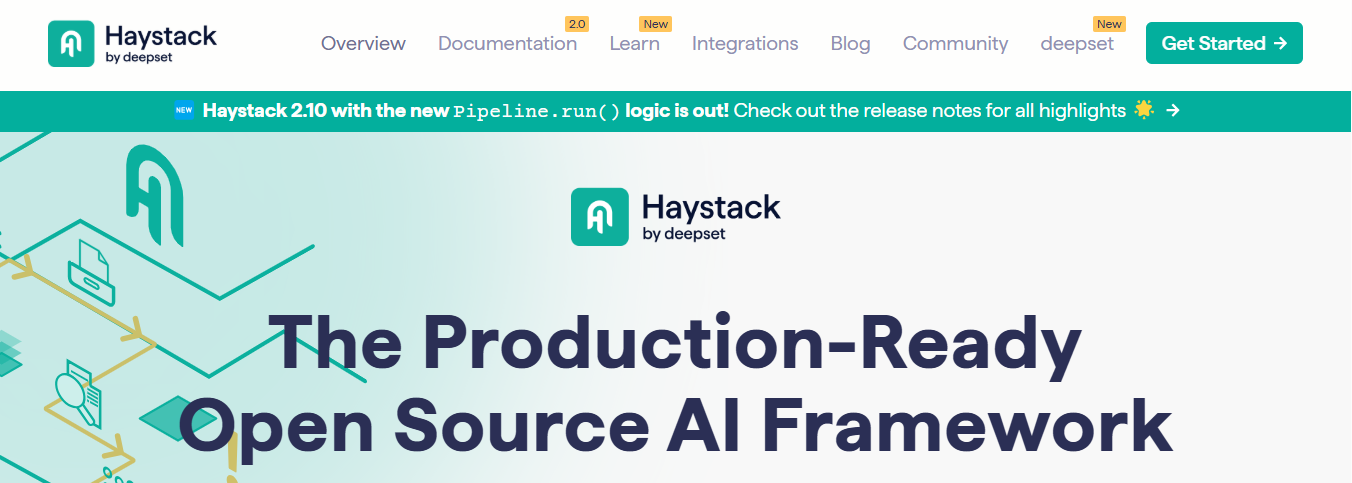
Developed by Deepset, Haystack is a mature, open-source framework that builds end-to-end NLP applications, particularly search, question answering, and RAG systems. It employs a pipeline architecture where nodes (Retriever, Reader, Generator, etc.) perform specific tasks on documents and queries.
Key Features
- Modular pipeline architecture
- Rich library of pre-built nodes
- Integration with various document stores:
- Elasticsearch
- OpenSearch
- Vector dbs
- Model-agnostic design
- Evaluation tools
- REST API deployment capabilities
Why it's an Alternative
Haystack offers a structured, code-centric (though conceptually clear) approach for production-ready systems. Its pipeline model is powerful for complex workflows, providing a different architectural paradigm than Flowise's graph-based visual approach.
Best Suited For
- Teams building production-grade semantic search
- Question-answering systems
- Complex RAG pipelines requiring robust components and evaluation frameworks
13. Langflow

Langflow is perhaps the most direct Flowise AI alternative. It mirrors Flowise's core concept by providing an open-source Graphical User Interface (GUI) specifically for LangChain. Users interact with a similar drag-and-drop canvas, connecting nodes representing LangChain components to design and execute LLM applications:
- LLMs
- Prompts
- Chains
- Agents
- Loaders
- Vector stores
Key Features
- Visual drag-and-drop interface, extensive component library based on LangChain,
- Real-time flow validation
- Integrated chat interface for testing
- Ability to export flows (typically as JSON)
Why it's an Alternative
It offers the same fundamental value proposition, visual construction of LangChain apps, but through its own distinct implementation, UI/UX choices, component set, and community focus. If Flowise doesn't quite meet your aesthetic or functional preferences, Langflow is the closest conceptual match.
Best Suited For
Users seeking a direct visual Flowise AI alternative, ideal for rapid prototyping and visually managing LangChain applications.
14. LlamaIndex: The Library
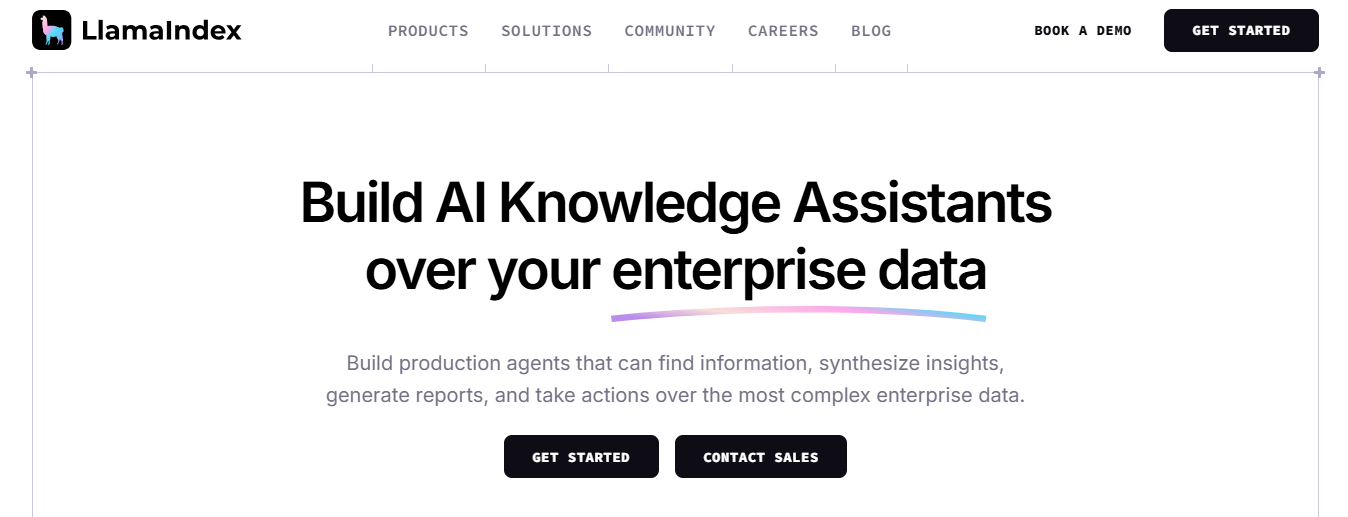
Similar to LangChain, LlamaIndex is a foundational framework. Still, it strongly emphasizes connecting LLMs with external data sources, particularly for advanced Retrieval-Augmented Generation (RAG).
It excels in:
- Data ingestion
- Indexing (vector stores, knowledge graphs, summarization)
- Complex query strategies over that data
Key Features
- Sophisticated RAG pipeline construction
- Wide array of data loaders
- Advanced indexing techniques (beyond simple vector search)
- Query transformation capabilities, often integrates with LangChain
Why it's an Alternative
Suppose your primary objective is building robust, data-intensive RAG systems. In that case, LlamaIndex offers specialized tools and abstractions potentially superior to those found in general-purpose visual builders or even LangChain's core RAG components. This is a code-first flowise ai alternative focused on data integration.
Best Suited For
Developers building applications heavily reliant on retrieving information from large, complex datasets, especially those needing advanced RAG capabilities.
15. ChainLit

ChainLit distinguishes itself by not being a flow builder. Instead, it's an open-source Python library designed to rapidly create chat interfaces for LLM applications, particularly those built with LangChain or LlamaIndex. Its strength is visualizing agents' and chains' intermediate steps ("thoughts" or chain-of-thought).
Key Features
- Extremely fast UI development for chat applications
- Built-in visualization of agent steps and reasoning
- Data persistence features
- Seamless integration with popular LLM frameworks, asynchronous support.
Why it's an Alternative
While Flowise provides a basic chat test interface, ChainLit is a dedicated solution for building polished, debuggable chat frontends directly from Python code. If your core need is a user-facing chat interface for your code-based LLM logic, ChainLit is a focused flowise ai alternative for the frontend aspect.
Best Suited For
Python developers who have built their LLM logic in code (e.g., using LangChain) need a quick, effective way to add a chat UI with built-in debugging and step visualization.
16. AutoGen
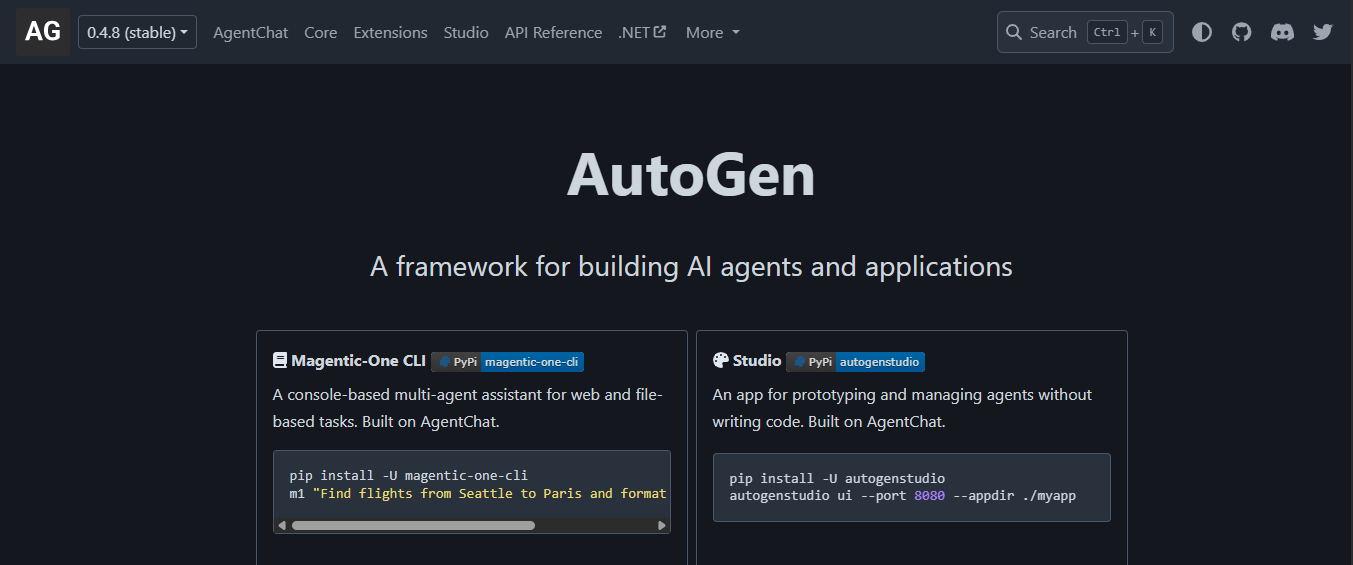
Originating from Microsoft Research, AutoGen is a framework designed to facilitate the development of applications leveraging multiple collaborating LLM agents. It provides structures for defining agents with different capabilities and enabling them to converse and work together to solve complex problems.
Key Features
- Multi-agent conversation framework
- Customizable agent roles and capabilities
- Support for human-in-the-loop workflows
- Integration with various LLMs and tools
Why it's an Alternative
Flowise allows agent creation, but AutoGen specializes in orchestrating sophisticated interactions between multiple agents.
If your application requires complex collaboration or task delegation among specialized AI agents, AutoGen offers a powerful (code-first) flowise ai alternative explicitly focused on this paradigm.
Best Suited For
Researchers and developers build applications that rely on the emergent capabilities of conversations and collaborations between multiple AI agents.
17. CrewAI
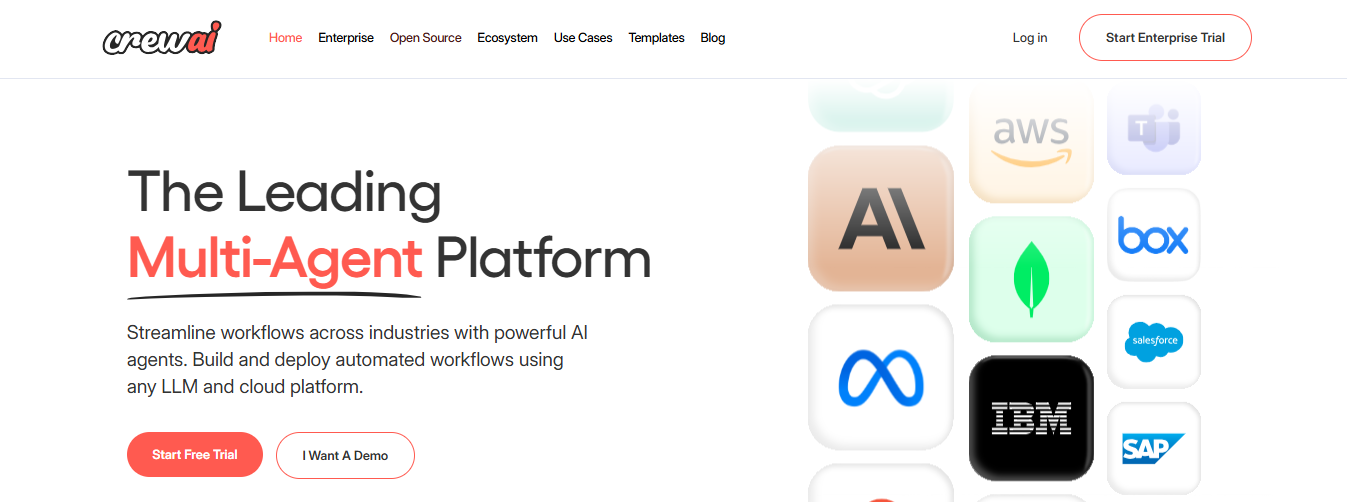
CrewAI is another framework centered on orchestrating autonomous AI agents, focusing on role-playing and structured collaboration processes. It helps define agents with specific roles, goals, backstories, and tools, enabling them to work together through defined processes like:
- Planning
- Task assignment
- Execution
Key Features
- Role-based agent design
- Flexible task management and delegation
- Defines structured collaboration processes:
- Hierarchical
- Consensual
- Tool integration for agents
Why it's an Alternative
Like AutoGen, CrewAI provides a code-first approach specifically for multi-agent systems. It offers a different flavor focused on explicit roles and structured task execution workflows. It's another specialized flows AI alternative for agent orchestration.
Best Suited For
Developers creating applications where tasks are best solved by a team of specialized AI agents operating within defined roles and following structured collaborative procedures.
18. LiteLLM

LiteLLM acts as a standardized interface or translation layer for interacting with over 100 different LLM providers (OpenAI, Anthropic, Cohere, Azure, Bedrock, Hugging Face, local models via Ollama, etc.). It allows you to call various models using a consistent OpenAI-compatible input/output format.
Key Features
- Unified API call format across numerous LLM providers
- Supports cloud-based and local LLMs
- Handles streaming responses
- Provides logging and exception mapping
- Can act as a proxy server
Why it's an Alternative
While not a direct builder, LiteLLM is a crucial enabling technology for many seeking a flowise ai alternative, especially in self-hosted scenarios. It abstracts away provider-specific API complexities, making it easy to switch models or use multiple backends (including local ones) within any LLM application framework.
Best Suited For
Developers need flexibility in their choice of LLM backends, want to switch between providers easily, or need to integrate locally hosted models seamlessly into their applications.
19. Ollama

Ollama has become incredibly popular for simplifying downloading, setting up, and running open-source LLMs (like Llama 3, Mistral, Phi-3, Gemma) directly on local hardware (macOS, Linux, Windows, including WSL).
It provides a command-line interface and a local REST API endpoint for the running models.
Key Features
- Straightforward setup for popular open-source LLMs
- Simple CLI for model management
- Local REST API mimicking OpenAI's structure
- Supports GPU acceleration
Why it's an Alternative
Ollama addresses the “self-hosted” aspect by making local model execution accessible. While Flowise can connect to APIs, Ollama provides the local API endpoint, giving full data privacy and offline capability and eliminating API costs. It's often used in conjunction with Flowise or its alternatives.
Best Suited For
Anyone wanting to run powerful LLMs locally for development, experimentation, privacy-critical tasks, or simply to avoid cloud API costs. A foundational tool for self-hosted AI.
20. FastChat
FastChat is an open platform focused on training, serving, and evaluating LLMs, particularly conversational models. It provides OpenAI-compatible RESTful APIs for serving various models and includes a web UI for demonstration and chat interaction (based on the Vicuna project). It excels at comparative benchmarking.
Key Features
- Distributed multi-model serving system
- OpenAI-compatible API endpoints
- Web UI for chat and comparison
- Tools for collecting data and evaluating model performance
Why it's an Alternative
Suppose your primary need is less about the visual building of flows (like Flowise) and more about robustly serving, interacting with, and evaluating multiple open-source models in a self-hosted environment. In that case, FastChat offers a strong infrastructure-focused Flowise AI alternative.
Best Suited For
Researchers or MLOps teams need to reliably serve multiple LLMs, benchmark their performance, and provide standard API access within their infrastructure.
21. AnythingLLM

AnythingLLM is marketed as a full-stack, private RAG application suitable for individuals and enterprises. It provides a user-friendly interface to connect various LLMs (including local ones via Ollama) and vector databases, upload and manage documents (PDF, DOCX, TXT, etc.), and securely chat with your knowledge base. It's available as a desktop app or can be self-hosted.
Key Features
- Polished UI designed explicitly for RAG workflows
- Document management and organization features
- Support for multiple users and permission levels
- Connects to diverse LLMs and vector DBs
- Has a strong emphasis on privacy
Why it's an Alternative
While Flowise can construct RAG pipelines, AnythingLLM is a pre-built, opinionated application dedicated to RAG. It offers a faster route to a functional, private document chat solution, sacrificing Flowise's general-purpose flexibility for a streamlined RAG experience. It's a targeted Flowise AI alternative for RAG use cases.
Best Suited For
Users or organizations needing an easy-to-deploy, private, multi-user RAG system for interacting with internal documents without extensive custom development.
22. MemGPT
MemGPT (Memory-GPT) is an open-source project tackling the critical limitation of fixed context windows in LLMs. It provides techniques and a library enabling LLMs to manage their own memory effectively, allowing agents to recall information and maintain coherence over much longer interactions than standard context windows permit.
Key Features
- Virtual context management to exceed native limits
- Long-term memory storage and retrieval mechanisms
- Function calling for intelligent memory access
- Integration into conversational agents
Why it's an Alternative
Suppose you are building complex conversational agents or assistants in Flowise and hitting limitations due to context window size or lack of long-term memory. In that case, MemGPT offers a code-first Flowise AI alternative component explicitly focused on solving this challenging memory management problem.
Best Suited For
Developers building sophisticated agents or chatbots that require robust long-term memory and the ability to handle extended conversations intelligently.
23. RAGatouille
RAGatouille is a focused Python library designed to make experimenting with and implementing “late-interaction” RAG models, particularly ColBERT, much easier. ColBERT performs fine-grained comparisons between query and document embeddings, often leading to superior retrieval results for nuanced queries compared to standard dense vector retrieval.
Key Features
- Simplified interface for ColBERT indexing and retrieval, integration points with LangChain and LlamaIndex
- Efficient implementation of ColBERT's computationally intensive steps
Why it's an Alternative
Flowise typically facilitates standard RAG using dense vector retrieval. RAGatouille provides easy access (via code) to a specific, often more powerful, RAG technique. If state-of-the-art retrieval quality is paramount, this library offers a specialized component, acting as a focused Flowise AI alternative for the retrieval part of RAG.
Best Suited For
Developers focused on maximizing RAG performance who want to leverage ColBERT's advanced capabilities without delving into its implementation details.
24. Marqo

Marqo is an end-to-end open-source vector search engine that uniquely integrates machine learning models directly into the indexing process. You provide your raw data (text, images), and Marqo handles the embedding generation and vector indexing automatically. It offers a simple API for multimodal search.
Key Features
- Integrated tensor/vector generation (no separate embedding step needed)
- Supports text, image, and combined text/image search
- Simple REST API
- Scalable deployment via Docker
Why it's an Alternative
While Flowise connects to external vector databases, Marqo simplifies the RAG backend significantly by bundling embedding creation and vector storage/search into one system. It's beneficial for multimodal scenarios.
Marqo could serve as the retrieval engine within a larger application built using other frameworks, acting as a streamlined flowise ai alternative for the vector search component.
Best Suited For
Developers looking for an easy-to-deploy, self-hosted vector search solution that handles embedding generation internally, especially valuable for multimodal search applications.
25. Voiceflow
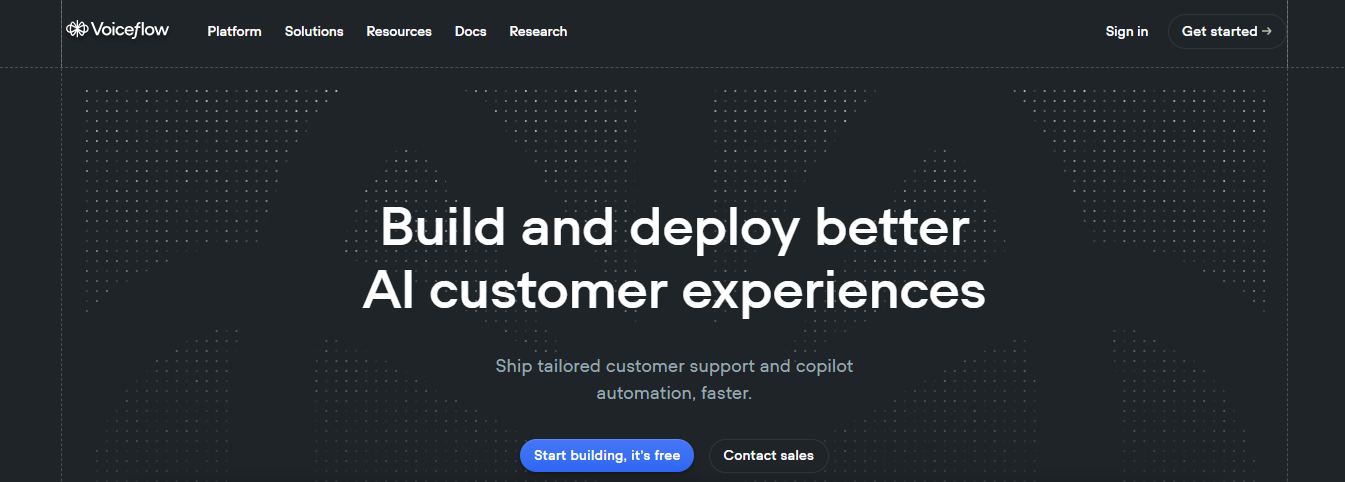
Voiceflow is a platform specifically designed for building conversational AI experiences, primarily voice assistants and chatbots.
- Ease of use: It is designed to make building complex conversational flows accessible even to non-coders with a drag-and-drop visual interface.
- AI model integrations: Voiceflow integrates with various LLMs, including Google's Dialogflow, Amazon Lex, and OpenAI's GPT models.
- Data connections: It has built-in integrations with popular platforms like Zapier, Make (formerly Integromat), and others.
If you're building voice assistants or chatbots, Voiceflow is a great option compared to Flowise. Its drag-and-drop interface makes it super user-friendly, making it easier to design complex conversational flows without coding. While Flowise is more versatile for general automation, Voiceflow excels at creating natural, engaging voice and chat experiences.
26. Relevance AI
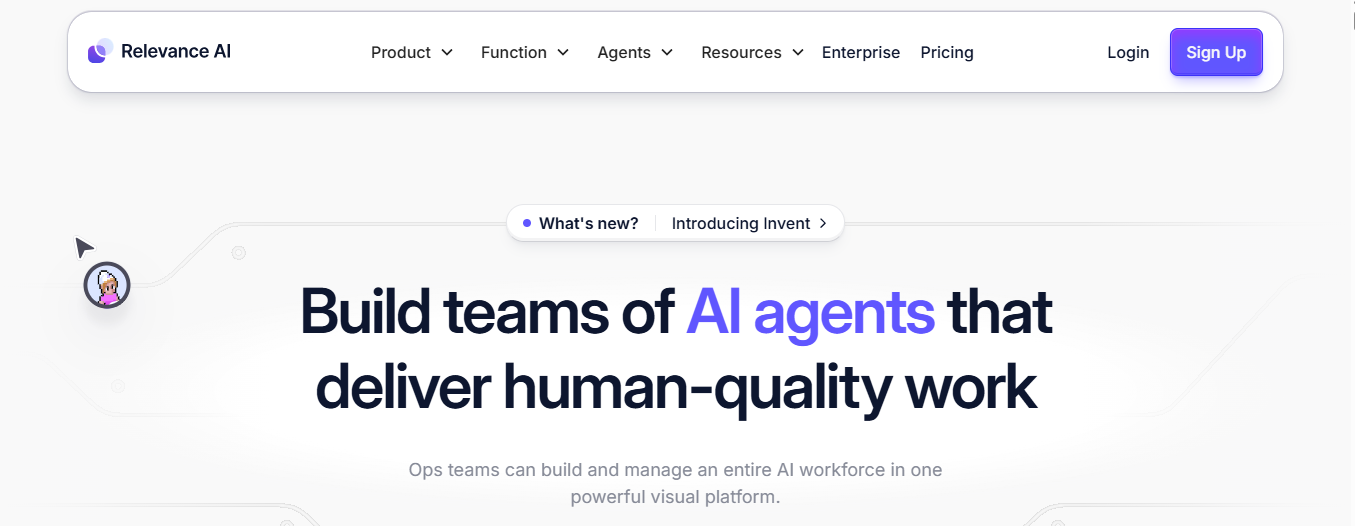
Relevance AI is a platform that focuses on building and deploying AI applications, including AI tools to AI agents to multi-agent teams. It facilitates and enables complex workflows related to vector search and semantic understanding.
- Ease of use: Relevance AI emphasizes ease of use, aiming to simplify the process of building AI applications.
- AI model integrations: It integrates with various data sources (databases, APIs, files), AI models (LLMs for embeddings)
- Data connections: It connects to various data repositories like applications (via APIs and SDKs), workflow automation tools (Zapier, Make, n8n), and CRMs.
While Flowise is a general-purpose workflow automation platform, Relevance AI specializes in providing the tools and infrastructure for efficient vector search and related AI tasks, simplifying their integration into your projects.
Related Reading
- Gen AI Architecture
- Generative AI Implementation
- Gen AI Platforms
- Generative AI Challenges
- Generative AI Providers
- How to Train a Generative AI Model
- Generative AI Infrastructure
- AI Middleware
- Top AI Cloud Business Management Platform Tools
- AI Frameworks
- AI Tech Stack
Start Building GenAI Apps for Free Today with Our Managed Generative AI Tech Stack
Lamatic offers a managed Generative AI tech stack that helps teams implement AI solutions faster and more efficiently. The Lamatic platform features an:
- Automated workflow
- Applications for edge deployment
- Integrated vector database
With Lamatic, users can build GenAI products and features without accruing tech debt. Start building GenAI apps for free today with Lamatic's managed generative AI tech stack.
What are the Benefits of Using Lamatic?
Lamatic lets teams build and deploy AI applications without the common pitfalls of developing emerging technology. For instance, Lamatic's automated workflows streamline processes and reduce the manual labor required to implement GenAI solutions, enabling teams to focus on building applications rather than getting lost in complex operations.
Furthermore, with GenOps and integrated vector databases, Lamatic ensures that GenAI applications are production-ready, equipped for fast edge deployment, and able to perform efficiently in real-world operations.





